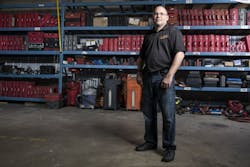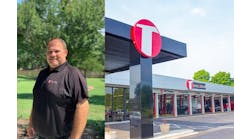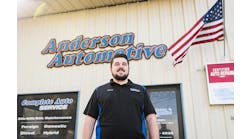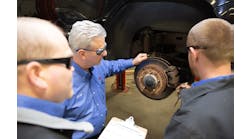After managing 45 employees at a dealership for two years, Brian Ordway knew he could successfully run his own automotive repair shop.
And he was right: Six months after opening Techway Automotive in Dothan, Ala., in 2010, Ordway’s 5,000-square-foot facility and staff of six was turning a profit. By 2012, Techway was pulling in $1.25 million annually.
Something was off, though. His technicians were pushing out plenty of work, but once you factored out the shop’s $2,500 average repair order (ARO) for diesel pickup trucks, the ARO was down near $250. He had carried over his managerial practices from the dealership and recruited the top technicians in the area … what could have possibly been wrong?
Here’s a hint: Ordway had no idea the shop’s ARO was so low until he signed up for a consulting service. His managerial leadership style didn’t carry over to his independent shop—he was so far removed from the repair process that he didn’t realize there was no established system for inspections.
Ordway had loftier goals of growing his business into a larger facility, of adding locations, of earning $500,000 a month in sales. And to take his business to the next level and become the $3 million business that exists today, he had to document and establish shop processes that would revamp courtesy inspections and, in turn, reshape the communication process between himself and his employees.
A service advisor at a General Motors dealership for eight years and a Nissan manager for two years, Ordway says he has a “pretty good track record” for turning businesses around. He managed 45 employees at the Nissan dealership.
For two years at Techway, Ordway had employed an attitude carried over from his previous managerial position: Remain handsoff and allow your technicians’ expertise to carry your reputation.
The quality of the technicians’ work wasn’t the issue, though— it was the lack of oversight to ensure every aspect of the vehicle was examined.
“I had always worked in dealerships, and I’d always had dealership processes,” he says. “I’d never set up my own systems and put processes down on pencil and paper.”
THE PROBLEM
Thanks to the high ARO for the shop’s regular diesel pickup truck work, which made up 50 percent of its sales before 2013, Techway’s revenue reached $1.25 million in 2012. His shop had made the high-dollar pickup jobs such a priority that general repair work wasn’t treated with the same level of attention.
“We’ve become known as the diesel guys, but I’m also fighting that to some extent because I want the quick stuff, too,” he says. “We want the oil changes and the tire work. We want to be a general shop that does everything.”
Unsure of how to move his business forward, Ordway joined the Automotive Training Institute (ATI). In the midst of trying to establish Techway as a go-to general repair shop in the area, his new business coach, John Leslie, questioned Ordway on his shop processes.
While evaluating the shop’s relatively low ARO of $250 on general repairs, Leslie pointed out there was no formal process for courtesy inspections.
“If you can get all the employees at the shop to walk through those courtesy inspections step by step to inspect everything and just let the customer know about any problems, you’d be surprised how many people will do it right then and there or come back later,” Ordway says.
Ordway realized there weren’t any established or documented processes in place at the shop. When it came to courtesy inspections, greeting customers and answering phones, none of it was laid out step by step, none of it was monitored by Ordway—and communicating those new processes would become essential for increasing revenue by 140 percent in three years and bringing the average monthly car count to 440.
THE SOLUTION
Ordway tinkered with ATI’s sample document to focus on small items that would lead to increased sales, such as timing belts, wiper blades, air filters—even tiny parts have added up for big boosts, like tag lights.
“We probably sell more tag lights than anyone else I can think of,” he says. “Nobody checks tag lights. That’s something simple, and yeah, there’s not huge money there. But if you do 10 a day, it starts adding up.”
However, getting employees to consistently check an item as small as tag lights? That was the real challenge. Ordway drafted an inspection sheet that made the tiniest of items an integral part of the courtesy check, drilling the new courtesy inspection process into his technicians’ heads at daily production meetings.
“On the inspection sheet, you have to pull off all four wheels and make sure the springs are good,” he says. “You’d be surprised how much stuff you find that would have been missed previously.”
When his new building added two alignment machines, Ordway started making tire sales a focus and required a tire reading on every inspection sheet. He would follow up on every inspection by going over the courtesy sheet, making sure every employee was on board with the company’s new focus.
“[Ordway] is very good at holding people accountable. And his employees respect him for that,” says Leslie. “We set the expectations out there right off the bat: ‘This is what we can do for you. This is what we need you to do for us. These are the expectations.’
“Then we lay out the production numbers across the board: ‘We need you to do X, Y and Z. We need the techs to do a certain amount of labor sales this week. We need this much in tires.’ Then we started creating processes.”
Once technicians were regularly checking off smaller repairs, Ordway slowly added more points of communication to the process, hiring a new employee dedicated to running his tire store and tracking tire inspections in the shop. Eventually, Ordway decided to go digital with the tire inspection process. He purchased a tablet and not only required his technicians to do tire readings, but take pictures of the tires, as well.
“We can just email that to a customer, which makes it a lot easier to sell that stuff,” he says. “‘Hey, here’s what your tire looks like, you’ll want some new ones.’”
Ordway also revamped the phone call SOPs. Ordway wrote out a script that guided service writers step by step through a phone call, asking about the key courtesy items that drive up the shop’s ARO. Staff is now required to get a name and phone number, ask about potential problems with the car, and invite the customer in for a courtesy inspection. Ordway monitors phone calls regularly and offers notes if service advisors aren’t following the script.
“When a customer calls, [our service writers] must say, ‘Let me get your phone number in case we get disconnected,’” he says. “That way, if they say they’ll check back with you, a day or two may pass, and you can call them back up and try to get them in the door.”
THE AFTERMATH
By documenting and training his staff on courtesy inspections, Ordway was able to raise his ARO to $570, increase sales exponentially and position Techway as an area leader in general repairs.
One year into his stint with ATI, Ordway had to find a new, larger building that could accommodate a larger staff. With consistent diesel work still flowing in, he moved into a 33,000-squarefoot facility in 2013, which now houses 15 lifts, five additional technicians and one more service writer that handle an average of 440 cars per month. Today, general repairs account for four-fifths of his annual $3 million revenue.
Once Ordway completed his three-year rotation with ATI, Techway accomplished something no ATI shop has ever achieved: Ordway walked away with “Best Service Sales,” “Most Improved Service Sales” and “Most Improved Tire Sales.”
“At the end of each year, they hand out awards for sales and gross profits,” he says. “No shop has ever won more than one award—and we won three.”
THE TAKEAWAY
With established processes enabling his shop to run smoothly, he’s now focusing on expanding his marketing efforts. He’s started regularly advertising on a local Christian radio station (listeners of which he says are the most loyal customers), and he’s hired an outside sales representative to obtain fleet accounts for the shop.
Ordway’s shop has gone from good to great, but he still strives for more, hoping to add more locations and achieve an average of $500,000 in sales per month.
“We’re looking at adding other options at the shop, like drive shaft repairs, spring repairs,” he says. “I figure, why stop now? Let’s run with this.”



